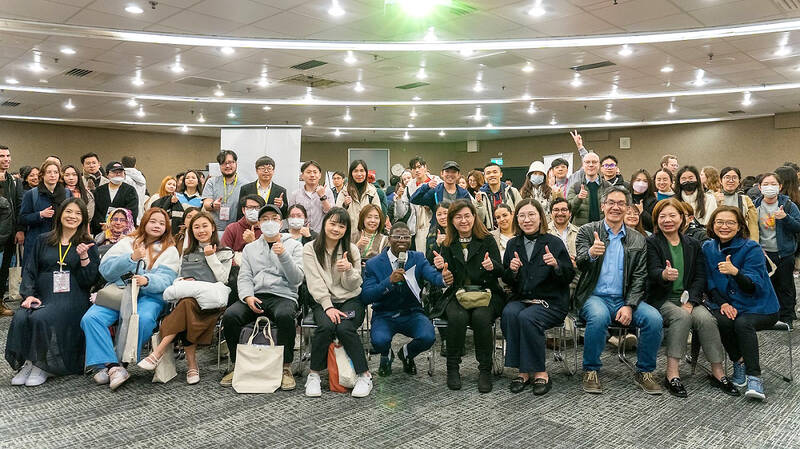With a booming tech sector and recent graduates flooding the market, many people are looking for jobs. If you are looking for a career in international business, LinkedIn is a must-have tool in your job finding toolbox. As long as it is used in the right way.
As a headhunter in the tech industry with 42,000 followers on LinkedIn (Amy) and an educator and published book author on LinkedIn and Job application writing (Nigel), we want to help you avoid the three biggest mistakes Taiwanese LinkedIn users make when looking for a job. And how to fix them.
WHY USE LINKEDIN?

Photo courtesy of the Ministry of Education
LinkedIn is the only social media for professionals. With 63 million corporate customers worldwide and 98 percent of Fortune 500 companies recruiting on LinkedIn, it is a powerful job search platform.
LinkedIn is slowly becoming more popular in Taiwan, especially with the younger generation. In 2022, the number of Gen Z users (16- to 26-year-olds) increased by 41 percent. However, it is interesting that there remains few LinkedIn users in Taiwan. In Hong Kong, over 70 percent of people have LinkedIn accounts. In Taiwan it is 13 percent.
Many Taiwanese still use job banks like Job Bank 104, CakeResume or Yourator to look for a job. And because their friends, family and teachers may not be familiar with LinkedIn, they assume it is not important or useful.

Photo: Reuters
Or, they may feel intimidated by all the English on LinkedIn. This is a shame since there are tools like ChatGPT to make writing in English relatively effortless. And LinkedIn has AI tools baked in to translate posts and even full courses into Chinese.
From our experiences as a headhunter and educator, we have found Taiwanese LinkedIn users make three common mistakes: incomplete profile, lacking detailed information and difficult-to-read language.
TIP 1: COMPLETE PROFILE
Even though the LinkedIn profile has three key sections (headline, about section and experiences section), there are many other sections that you can add information to, like education, licenses, skills and recommendations.
The more complete your profile is for a sales rep in the tech industry, for example, the more sales and tech related words will appear in your profile. This means you will be easier for recruiters (or anyone) to find when they are looking for a sales rep in tech. This is how search engine optimization works for Web sites.
Most Fortune 500 companies use LinkedIn’s recruiter system, a powerful tool that uses an intelligent algorithm to help recruiters find potential candidates. It uses over 40 advanced search filters, including skills, past experiences and location, to find the most suitable candidates for a job.
TIP 2: DETAILED INFORMATION
Many job seekers do not spend enough time writing their resumes or LinkedIn profiles. Just like with any form of writing, you need to know what information your reader needs and how to present it in the way they expect.
Let’s continue with the sales example. If you are a sales rep who has worked at a few companies, you need to spend time adding enough job details to help the non-specialist, like the HR officer or headhunter. The reader probably won’t know what your company does, and what products they sell or which products you worked on. This context information helps recruiters understand better if you are a good fit for the position they are trying to fill.
Numbers are very important for complete information but also credibility. How many years’ experience do you have? What were your contributions and achievements? Numbers are the language of persuasion that recruiters are looking for.
TIP 3: EASY-TO-READ LANGUAGE
The “about” section is where you want to highlight your personality, skills, experience and education that are most relevant for the job you are applying for. This also means making your achievements and contributions as clear as possible.
This is not the place to talk about your family history or your life philosophy. Recruiters only want to see the relevant details, as quickly and as easily as possible.
So, it is a good idea to use short sentences and paragraphs, and where possible use bullets. Avoid technical jargon or abbreviations that may not be understood by everyone. Focus on making the language as easy as possible for everyone to read.
AI tools like Google Gemini or ChatGPT are good for this. Give the AI your relevant details and ask it to write a LinkedIn “about” section in short sentences and paragraphs and where possible, bullets.
Following these three tips will sharpen your most useful tool for finding a job at an international company. Once you complete your profile, add many relevant details about your skills and experiences, make your language as readable as possible, you will be able to take advantage of the power of LinkedIn and increase success in your job search.
Nigel P Daly is an author and business communications instructor at TAITRA’s International Trade Institute. He has a PhD in English, TESOL, from National Taiwan Normal University.
Amy Pang is a headhunter by profession and a mother by identity and runs a website called 99moms. She shares articles about work and life on LinkedIn for more than 42,000 followers.

On April 26, The Lancet published a letter from two doctors at Taichung-based China Medical University Hospital (CMUH) warning that “Taiwan’s Health Care System is on the Brink of Collapse.” The authors said that “Years of policy inaction and mismanagement of resources have led to the National Health Insurance system operating under unsustainable conditions.” The pushback was immediate. Errors in the paper were quickly identified and publicized, to discredit the authors (the hospital apologized). CNA reported that CMUH said the letter described Taiwan in 2021 as having 62 nurses per 10,000 people, when the correct number was 78 nurses per 10,000

As we live longer, our risk of cognitive impairment is increasing. How can we delay the onset of symptoms? Do we have to give up every indulgence or can small changes make a difference? We asked neurologists for tips on how to keep our brains healthy for life. TAKE CARE OF YOUR HEALTH “All of the sensible things that apply to bodily health apply to brain health,” says Suzanne O’Sullivan, a consultant in neurology at the National Hospital for Neurology and Neurosurgery in London, and the author of The Age of Diagnosis. “When you’re 20, you can get away with absolute

May 5 to May 11 What started out as friction between Taiwanese students at Taichung First High School and a Japanese head cook escalated dramatically over the first two weeks of May 1927. It began on April 30 when the cook’s wife knew that lotus starch used in that night’s dinner had rat feces in it, but failed to inform staff until the meal was already prepared. The students believed that her silence was intentional, and filed a complaint. The school’s Japanese administrators sided with the cook’s family, dismissing the students as troublemakers and clamping down on their freedoms — with

As Donald Trump’s executive order in March led to the shuttering of Voice of America (VOA) — the global broadcaster whose roots date back to the fight against Nazi propaganda — he quickly attracted support from figures not used to aligning themselves with any US administration. Trump had ordered the US Agency for Global Media, the federal agency that funds VOA and other groups promoting independent journalism overseas, to be “eliminated to the maximum extent consistent with applicable law.” The decision suddenly halted programming in 49 languages to more than 425 million people. In Moscow, Margarita Simonyan, the hardline editor-in-chief of the